|
|
For 2005, Subaru has given the Outback a reasonably meaningful facelift. The inside has been totally redesigned, with the dash and trim getting a substantial gussying up, and many small, lingering annoyances finally getting addressed. On the outside, Subaru has lowered the engine, reducing the center of gravity, and managed to drop several hundred pounds by switching to aluminum for the rear hatch and other components.
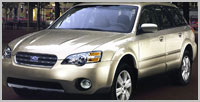 The model we drove was a new, 2.5-liter, turbo-charged, four-cylinder engine. It's not quite the top of the line, but it's close. The Outback tops out with the 3.0 R VDC Limited Edition, which includes dynamic stability control and a six-cylinder engine. The model we drove was a new, 2.5-liter, turbo-charged, four-cylinder engine. It's not quite the top of the line, but it's close. The Outback tops out with the 3.0 R VDC Limited Edition, which includes dynamic stability control and a six-cylinder engine.
|
|
 |
The driving experience is definitely improved. It feels tighter than the old Outback. The car doesn't shake or twist nearly as much on bumps and stuff. It handles and corners very tightly. In windy conditions, we noticed that the Outback was clearly more stable, thanks to the lower center of gravity.
The turbo engine is a bit of a mixed bag. There is plenty of power, but when the turbo kicks in at slower speeds, your neck snaps back, and not necessarily comfortably so. It's nice, however, when you're going 40 or 50 miles an hour and you step on it. The turbo gives you an extra surge of power for passing or climbing a hill. The automatic transmission is a nice touch, especially because it somewhat smoothes out the effects of the turbo. Two downsides of the turbo, however: You'll shave several MPG's off your fuel economy, and Subaru recommends using only premium fuel - a fact you will be reminded of every time you fill up. In fact, we estimate it'll cost you about extra $1,500 in fuel costs over the life of the car.
|
|
 |
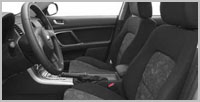 The interior is vastly improved for Subaru, which has featured some of the most God-awful, ugly interiors. You know: the sort of seat fabrics that looked like somebody barfed and they turned it into a pattern. The version we drove has very nice, tasteful black leather with some touches of aluminum on the dash. There are a number of nooks and crannies, but it would be nice if the middle armrest fell where your arm did. It's too low, which on long drives left us feeling like we were tilting somewhat to starboard. The interior is vastly improved for Subaru, which has featured some of the most God-awful, ugly interiors. You know: the sort of seat fabrics that looked like somebody barfed and they turned it into a pattern. The version we drove has very nice, tasteful black leather with some touches of aluminum on the dash. There are a number of nooks and crannies, but it would be nice if the middle armrest fell where your arm did. It's too low, which on long drives left us feeling like we were tilting somewhat to starboard.
The 2005 Outbacks are a bit wider on the inside than previous model years, which we thought really improved matters. There's more shoulder room, and it feels less like a traditional, narrow Japanese car.
|
|
 |
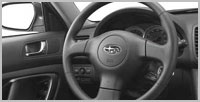 The gauges are backlit and very nice-looking. The dashboard is nice and simple. The car could use a radio tuner dial, instead of the "up/down" buttons. The right side, where the tuner dial could go, switches between AM, FM or CD. One other thing about the radio, though: You'd better like it, because it's integrated into the center console. There's no swapping this radio for a top-of-the-line, AM/FM/satellite radio receiver. The gauges are backlit and very nice-looking. The dashboard is nice and simple. The car could use a radio tuner dial, instead of the "up/down" buttons. The right side, where the tuner dial could go, switches between AM, FM or CD. One other thing about the radio, though: You'd better like it, because it's integrated into the center console. There's no swapping this radio for a top-of-the-line, AM/FM/satellite radio receiver.
Subaru also decided to place shifter buttons instead of radio controls on the steering wheel. We don't know about you, but we use the radio controls a lot more often than those manual shift options. More than anything, that shift option is just a toy - we bet every owner will use it a few times, and then forget about it.
The sunroof is wonderfully large and opens in several different ways, which is a great feature. The aluminum rear hatch is amazingly light to lift, which is quite nice.
|
|
 |
The 2005 Outback is an inch wider and longer than last year's model. The wider and longer track adds to the Outback's stability.
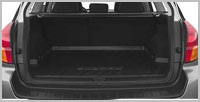 Overall, Subaru is looking to take their brand upscale over time. The exterior has been Europeanized a bit: smoothed out and streamlined, with much less of Subaru's usual over-the-top cladding. Our first thought was that it looks pretty similar to the old Legacy Outback. There are a lot of slight tweaks and refinements on the outside, but you'll definitely recognize it as an Outback. Unfortunately, the turbo edition still features a hood scoopa feature that Subaru insists is strictly functional. (The other versions have, thankfully, lost the ugly scoop.) Overall, Subaru is looking to take their brand upscale over time. The exterior has been Europeanized a bit: smoothed out and streamlined, with much less of Subaru's usual over-the-top cladding. Our first thought was that it looks pretty similar to the old Legacy Outback. There are a lot of slight tweaks and refinements on the outside, but you'll definitely recognize it as an Outback. Unfortunately, the turbo edition still features a hood scoopa feature that Subaru insists is strictly functional. (The other versions have, thankfully, lost the ugly scoop.)
|
|
 |
Subaru's are relatively straightforward to service and repair. Parts are plentiful and readily available if you live in a part of the country that gets snow. Elsewhere, Subarus are a bit less common.
Another bit of good news: Your local mechanic can do almost all the work on this car.
A word of caution: If you're going to buy the six-cylinder version of the Outback, be prepared to pay an extra "knuckle bashing" fee for servicing. The engine is very, very tightly crammed into its compartment, making almost all service and repair challenging and more time consuming.
|
|
 |
Traditionally, Subarus have been pretty reliable. We don't think they're quite in a league with the Hondas and Toyotas of the world, but they're pretty close. And we hear of plenty of Subarus that get the pistons beat out of them, and keep running for hundreds of thousands of miles. All in all, we'd expect this new Outback to be just as reliable - though don't be expecting to have the turbo run forever without at least one expensive repair.
|
|
 |
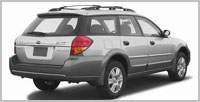 The top-of-the-line model we drove has a list price of $30,800, which is really starting to get up there. Other versions include a hatchback Sport model, that lists for $19,000; the Outback Limited with heated leather seats and sunroof, that lists for $27,100; and the top-of-the-line, 3.0 R VDC Limited, with a list price of $33,500. The top-of-the-line model we drove has a list price of $30,800, which is really starting to get up there. Other versions include a hatchback Sport model, that lists for $19,000; the Outback Limited with heated leather seats and sunroof, that lists for $27,100; and the top-of-the-line, 3.0 R VDC Limited, with a list price of $33,500.
All in all, we thought the Outback was a very nice car that does everything well. Is it in a class with an Audi A6? Not really. But if you're looking for a reliable wagon, all-wheel drive, and a little bit of pampering, this would be a great choice.
|


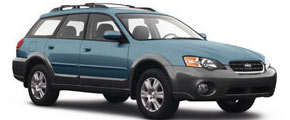





 The model we drove was a new, 2.5-liter, turbo-charged, four-cylinder engine. It's not quite the top of the line, but it's close. The Outback tops out with the 3.0 R VDC Limited Edition, which includes dynamic stability control and a six-cylinder engine.
The model we drove was a new, 2.5-liter, turbo-charged, four-cylinder engine. It's not quite the top of the line, but it's close. The Outback tops out with the 3.0 R VDC Limited Edition, which includes dynamic stability control and a six-cylinder engine.

 The interior is vastly improved for Subaru, which has featured some of the most God-awful, ugly interiors. You know: the sort of seat fabrics that looked like somebody barfed and they turned it into a pattern.
The interior is vastly improved for Subaru, which has featured some of the most God-awful, ugly interiors. You know: the sort of seat fabrics that looked like somebody barfed and they turned it into a pattern. 


 Overall, Subaru is looking to take their brand upscale over time. The exterior has been Europeanized a bit: smoothed out and streamlined, with much less of Subaru's usual over-the-top cladding. Our first thought was that it looks pretty similar to the old Legacy Outback. There are a lot of slight tweaks and refinements on the outside, but you'll definitely recognize it as an Outback. Unfortunately, the turbo edition still features a hood scoopa feature that Subaru insists is strictly functional. (The other versions have, thankfully, lost the ugly scoop.)
Overall, Subaru is looking to take their brand upscale over time. The exterior has been Europeanized a bit: smoothed out and streamlined, with much less of Subaru's usual over-the-top cladding. Our first thought was that it looks pretty similar to the old Legacy Outback. There are a lot of slight tweaks and refinements on the outside, but you'll definitely recognize it as an Outback. Unfortunately, the turbo edition still features a hood scoopa feature that Subaru insists is strictly functional. (The other versions have, thankfully, lost the ugly scoop.)


 The top-of-the-line model we drove has a list price of $30,800, which is really starting to get up there. Other versions include a hatchback Sport model, that lists for $19,000; the Outback Limited with heated leather seats and sunroof, that lists for $27,100; and the top-of-the-line, 3.0 R VDC Limited, with a list price of $33,500.
The top-of-the-line model we drove has a list price of $30,800, which is really starting to get up there. Other versions include a hatchback Sport model, that lists for $19,000; the Outback Limited with heated leather seats and sunroof, that lists for $27,100; and the top-of-the-line, 3.0 R VDC Limited, with a list price of $33,500.